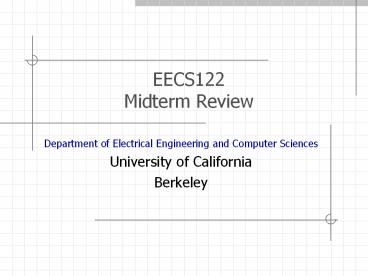EECS122 Midterm Review PowerPoint PPT Presentation
Title: EECS122 Midterm Review
1
EECS122Midterm Review
- Department of Electrical Engineering and Computer
Sciences - University of California
- Berkeley
2
TOC Midterm Review
- Network
- Web Browsing
- Layers Protocols
- Inside a Router
- Check List
3
Review Network
WAN
MAN
4
Review Network
WAN
LAN
MAN
5
Review Network
WAN
LAN
6
Review Web Browsing
- Example
- Locating Resource DNS
- Connection
- End-to-end
- Packets
- Bits
- Points to remember
7
Web Example
- Click Link or URL
- ? get content from localor remote computer
- URL
- http//www.google.com/string
- Specifies
- Protocol http
- Computer www.google.com
- String
- Computer (server) selects
- contents based on string
8
Web Locating Resource
- www.google.com is the name of a computer
- Network uses IP addresses
- To find the IP address, the application uses a
hierarchical directory service called theDomain
Name System
9
Web Connection
- The protocol (http) sets up a connection between
the host and cnn.com to transfer the page - The connection transfers the page as a byte
stream, without errors pacing error control
10
Web End-to-end
- The byte stream flows from end to end across many
links and switches routing ( addressing) - That stream is regulated and controlled by both
ends retransmission of erroneous or missing
bytes flow control
11
Web Packets
- The network transports bytes grouped into packets
- The packets are self-contained and routers
handle them one by one - The end hosts worry about errors and flow
control - Destination checks packet for errors (using error
detection code CKS) and sends ACKs with sequence
number - Source retransmits packets that were not ACKed
and adjusts rate of transmissions
12
Web Bits
- Equipment in each node sends the packets as a
string of bits - That equipment is not aware of the meaning of the
bits
13
Review Layers Protocols
14
Mapping Layers to Network Devices
- Two broad classes of devices
- Hosts
- Routers
- Both sets of devices run applications
- Hosts mainly run user applications
- Routers run infrastructure applications
- E.g. Topology discovery, Network Management
Protocols, BGP etc. - Dont be confused by thinking that routers dont
run application protocols because they are layer
3 devices
15
Layers Transport Services
HTTP
DNS
RA
Application
Transport
IP
A B p1 p2
UDP Not reliable TCP Ordered, reliable,
well-paced
16
Layers - TCP MPX, Error, Flow and Congestion
Control
65KB
- window minRAW - OUT, W
W
3DA
3DA
TO
X0.5
X0.5
X0.5
X0.5
3
3
TO
1
CA
SS
SS
CA
17
TCP Algorithm AIMD
18
Flow Control
- Objective Avoid saturating destination
- Algorithm Receiver avertizes window RAW
window minRAW OUT, W where OUT
Oustanding Last sent last ACKed W Cong.
Window from AIMD refinements
RAW
19
Layers IP Internet Protocol
- Addressing
- Class-Based Fixed Prefix M-tree
- Classless CIDR LPM-Patricia Trie
- Routing
20
Class-base Addressing
- Addressing reflects internet hierarchy
- 32 bits divided into 2 parts
- Class A
- Class B
- Class C
21
Classless Internet Domain Routing
- Suppose fifty computers in a network are
assigned IP addresses 128.23.9.0 - 128.23.9.49 - Range is 01111111 00001111 00001001
00000000 to 01111111 00001111 00001001
00110001 - They share the first 26 bits of 128.23.9.0
- Convention 128.23.9.0/26 prefix
- There are 32-276 bits for the 50 computers
- 26 64 addresses
22
IP Routing
- Intradomain
- Formulate the routing problem as a Shortest Path
Problem - Link State v/s Distance Vector
- Both work reasonably well in a well engineered
network
4
4
6
B
BGP
6
7
5
IntraDomain
2
2
4
8
RIP
6
3
13
3
13
11
2
10
IntraDomain
IntraDomain
3
1
13
12
- Interdomain
- BGP
- Path Vector, Policies
C
OSPF
IGRP
23
Route Computation
- Dijkstra Link State
- Use a flooding protocol to discover the entire
topology - Find the shortest paths in order of increasing
path length from node i. - Bellman Ford Distance Vector
- D(i,d) minjeN(i) c(i,j) D(j,d)
- BGP Path Vector
- Policy routing Receive and advertise entire
routes - AS numbers describe the path to a CIDR address
Choose best route
accept, deny, set preferences
forward, not forward set MEDs
Routes received from neighbors
Routes sent to neighbors
Import Policy Engine
Export Policy Engine
Routes used by router
Decision process
IP Routing table
BGP table
24
Review Inside Router
- Input and output interfaces are connected through
an interconnect - A interconnect can be implemented by
- Shared memory
- low capacity routers (e.g., PC-based routers)
- Shared bus
- Medium capacity routers
- Point-to-point (switched) bus
- High capacity routers
Scheduling
GPS WFQ
25
Router GPS/WFQ
- Why service disciplines?
- Understand GPS and WFQ well
- GPS properties
- WFQ tracking result
- No later than one packet transmission
26
Review Check List
- Big Picture
- Layers
- Network Structure (L2, L3)
- Where protocols are implemented
- Switching Techniques
- Applications
- DNS
- HTTP
- Transport
- TCP Service Go Back N Flow Control Congestion
Control AIMD SS 3DA Phases - UDP Service
- Network
- Class-Based Classless Addressing
- Dijkstra Bellman-Ford
- Hierarchical routing
- Inside Router
- Architecture Input, Output
- Scheduling Fairness, GPS, WFQ

